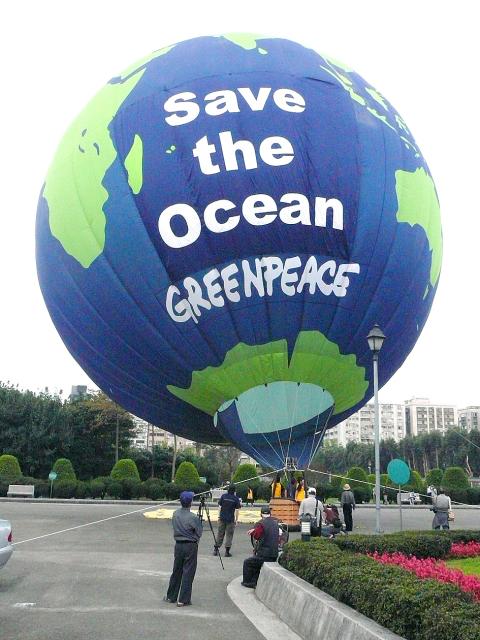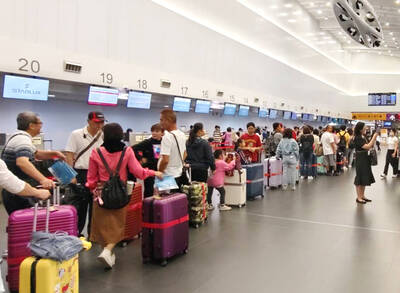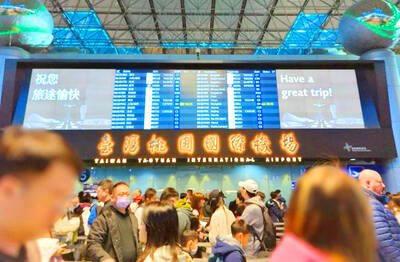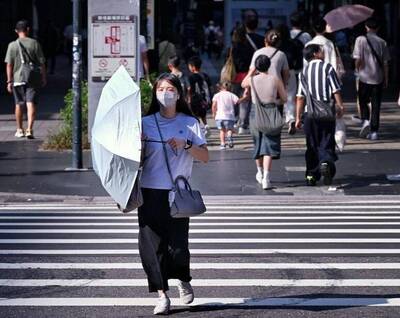Greenpeace Taipei used a hot-air balloon to draw attention to marine conservation yesterday, in advance of a Western and Central Pacific Fisheries Commission (WCPFC) meeting.
“The hot-air balloon is here to tell people of the urgent need for changes in the way we manage Pacific fisheries at this year’s meeting in Guam,” said Yen Ning (顏寧), the group’s oceans campaigner.
Although the environmental -activist group was not able to release the balloon because of strong winds, the event still drew a lot of attention.

Photo: EPA
Yen accused the government of a lukewarm response to appeals from environmental groups for a more aggressive approach toward oceans conservation. Since Taiwan has one of the world’s largest and least regulated fishing fleets, she said, it should be held responsible for protecting the Pacific Commons, which are being overfished.
Yen also urged the Fisheries Agency to support the closing off of other ocean areas and the establishment of conservation zones to protect endangered fish species.
To build up awareness ahead of the meeting, she added, the organization’s ship, MV Esperanza, will arrive in Kaohsiung Harbor on March 23, three days before the talks begin.
Fisheries Agency Deputy -Director-General Tsay Tzu-yaw (蔡日耀) said on Friday that the agency was fully aware of the need for sustainable fishing and was prepared to discuss the issue with member countries “if the issue was brought up at the meeting.”

Three Taiwanese airlines have prohibited passengers from packing Bluetooth earbuds and their charger cases in checked luggage. EVA Air and Uni Air said that Bluetooth earbuds and charger cases are categorized as portable electronic devices, which should be switched off if they are placed in checked luggage based on international aviation safety regulations. They must not be in standby or sleep mode. However, as charging would continue when earbuds are placed in the charger cases, which would contravene international aviation regulations, their cases must be carried as hand luggage, they said. Tigerair Taiwan said that earbud charger cases are equipped

Foreign travelers entering Taiwan on a short layover via Taiwan Taoyuan International Airport are receiving NT$600 gift vouchers from yesterday, the Tourism Administration said, adding that it hopes the incentive would boost tourism consumption at the airport. The program, which allows travelers holding non-Taiwan passports who enter the country during a layover of up to 24 hours to claim a voucher, aims to promote attractions at the airport, the agency said in a statement on Friday. To participate, travelers must sign up on the campaign Web site, the agency said. They can then present their passport and boarding pass for their connecting international

Temperatures in northern Taiwan are forecast to reach as high as 30°C today, as an ongoing northeasterly seasonal wind system weakens, the Central Weather Administration (CWA) said. CWA forecaster Tseng Chao-cheng (曾昭誠) said yesterday that with the seasonal wind system weakening, warmer easterly winds would boost the temperature today. Daytime temperatures in northern Taiwan and Yilan County are expected to range from 28°C to 30°C today, up about 3°C from yesterday, Tseng said. According to the CWA, temperature highs in central and southern Taiwan could stay stable. However, the weather is expected to turn cooler starting tonight as the northeasterly wind system strengthens again

Taiwan sweltered through its hottest October on record, the Central Weather Administration (CWA) said yesterday, the latest in a string of global temperature records. The main island endured its highest average temperature since 1950, CWA forecaster Liu Pei-teng said. Temperatures the world over have soared in recent years as human-induced climate change contributes to ever more erratic weather patterns. Taiwan’s average temperature was 27.381°C as of Thursday, Liu said. Liu said the average could slip 0.1°C by the end of yesterday, but it would still be higher than the previous record of 27.009°C in 2016. "The temperature only started lowering around Oct. 18 or 19